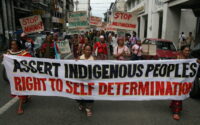Using Multimedia to address Journalism’s Crisis: Response to Wilson Shultz’ Blog Post
by Sarah Gilsoul, November 23, 2021

Compared to conventional journalistic writing, multimedia pieces offer multiple modes of user interaction and various ways a reader can read and understand a story. Rather than the journalist providing only text and images, multimedia involves other ways for users to consume the story, including videos, interviews, pictures, and slideshows.
In contrast to stories written in a traditional journalistic style, multimedia also has the potential to decolonize, or at least acknowledge biases in the journalistic process. Using a non-linear format, which is a major component in multimedia, especially when used in feature stories, can pay homage to culturally diverse ways of knowing and is an example of decolonizing media.
For example, Indigenous peoples in the Americas have been using storytelling as a form of community governance, identification, and preservation since time immemorial (Gilpin, 2018). Storytelling for Indigenous groups in America tends to follow a non-linear format, and incorporating that into journalistic practice acknowledges Indigenous people’s understanding of events (Canadian Geographic). While the journalist ultimately has control over what is presented in the story overall, multimedia pieces, if done right, can show the varying perspectives and angles revolving around an issue.
Historically journalistic norms have dictated that authors must remain objective and distant from the issues that they present. However, as explained by Callison and Young in “Opening up to Journalism’s Crisis,” objectivity cannot be truly achieved, especially when reporting on issues that are complicated or describe incomprehensible trauma. According to the authors, claiming to be a neutral observer is rooted in the masculine tendency to distance oneself from “implicatedness” and serves as a way for journalists to remove themselves from the issues they report on and the effect their reporting has on society.
This perceived objectivity has the effect of presenting journalistic writing as fact, when the reality is that journalists cannot escape their own biases nor the systemic racist and sexist biases within journalism as an institution. Prejudices and stereotypes, as presented as facts, can have lasting implications on how we perceive people. For example, National Geographic failed to acknowledge Native peoples within the United States and instead portrayed Indigenous peoples from other counties as “exotic” others from distant lands for much of the magazine’s history (Wamsley, 2018). As a result, many people in western culture today fail to recognize that there are still Indigenous people in the US and that their perspectives and stories still matter and deserve to be told (Hedgpeth and Hatzipanagos, 2021).
Through the use of multimedia, Indigenous peoples and other underrepresented groups can tell their own stories through interviews or even through their own multimedia projects. In an interview conducted by Ashley Hernandez, Nidia Bustillos explained that technology and the new types of alternative media that are more accessible to those outside of journalistic institutions provide an opportunity for Indigenous peoples to “re-appropriate technology and communication to spotlight Indigenous women’s empowerment, voices, and struggles,” (Hernandez, 2017).
Though not a multimedia project, the documentary “Angry Inuk” serves as an example of how Indigenous perspectives can be included and even centered in issues that heavily involve Indigenous communities. Rather than centering white western voices as the progressive and rational way to address a problem, “Angry Inuk” highlights how animal rights organizations failed to share the stories and perspectives of the Inuit people, despite the direct influence that seal hunting has on their way of life. While viewers still may not entirely agree with their practices, including the Indigenous perspective clarifies that the issue is complex, as are most issues that journalists report. Multimedia projects can easily integrate diverse perspectives and greater representation into journalism by including interviews and footage from documentaries like “Angry Inuk.”
This story was updated on 12/9/2021. The primary changes involved reorganization.
Sources
Arnaquq-Baril, A. (Director). (2016). Angry Inuk [Video file]. Film Movement.
Canadian Geographic. (n.d.). Oral tradition. Indigenous Peoples Atlas of Canada. Retrieved November 23, 2021, from https://indigenouspeoplesatlasofcanada.ca/article/oral-tradition/.
Dana Hedgpeth, R. H. (2021, November 19). Perspective | ‘we are still here’. The Washington Post. Retrieved November 23, 2021, from https://www.washingtonpost.com/nation/interactive/2021/native-american-heritage-month-were-still-here/.
Gilpin, Emilee. (2018, December 11). Indigenous journalists speak up. Canada’s National Observer.
Hernandez, A. (2017, September 6). Reclaiming the narrative: Indigenous Media as a tool of empowerment. International Funders for Indigenous Peoples. Retrieved November 23, 2021, from https://internationalfunders.org/reclaiming-the-narrative-indigenous-media-has-a-tool-of-empowerment/.
Schultz, Wilson. (2021, November 9). Non-Linear Storytelling Using Multimedia. Environmental Journalism WordPress
Wamsley, L. (2018, March 12). ‘National Geographic’ reckons with its past: ‘for decades, our coverage was racist’. NPR. Retrieved November 23, 2021, from https://www.npr.org/sections/thetwo-way/2018/03/12/592982327/national-geographic-reckons-with-its-past-for-decades-our-coverage-was-racist.


